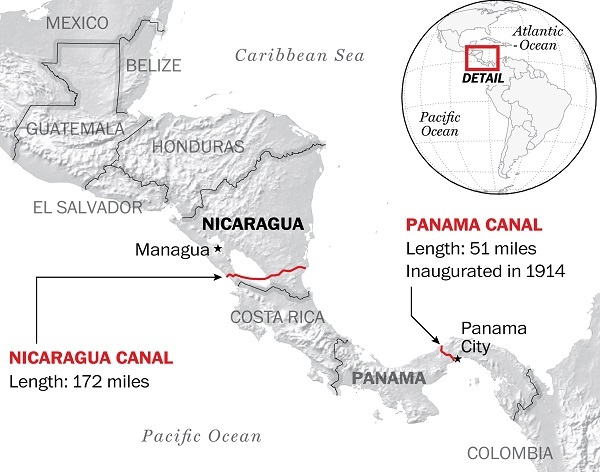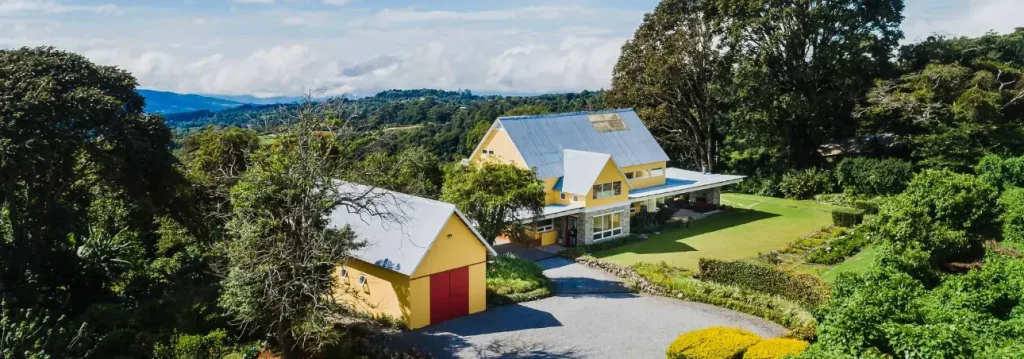
They have inaugurated the project and so it begins. This article makes a strong case that the Nicaragua project which competes with the Panama Canal will never come to fruition.
In summary: It is expected to cost $50,000,000,000 and would be a major economic benefit to a very poor country. There was no transparency in the process, the deal calls for the developer to do whatever he wants without local taxes or regulations including the ability to expropriate land from Nicaraguan citizens and the developer says the Chinese government is not backing him. Also, Nicaragua maintains relations with Taiwan, not Beijing, the project is likely to decimate critical Lake Nicaragua and make its water undrinkable as well as displace tens of thousands of Nicaraguans including indigenous people. Plus with the expanded Panama Canal as competition, it will be challenging for them to turn a profit within the next thirty years.
The wildcard as I see it: As the article said, this project is potentially “China’s biggest footprint in Latin America.” If the Chinese government is actually involved behind the scenes in this project or takes it over at a later date, then many of the above considerations could become irrelevant. The prestige and more importantly, the strategic advantages to controlling the passage may drive the project forward. Right now, it seems a long shot, but if China decides it is important at some point, all bets are off and it could actually happen. On another note, the pundits may be underestimating the potential of the project. It has happened before.
On Monday, Nicaraguan dignitaries and officials from a Hong Kong-based consortium inaugurated what could be the most ambitious infrastructure project in the Western Hemisphere. The planned Grand Canal of Nicaragua would span 172 miles across the Central American nation, cutting through Lake Nicaragua, the region’s largest freshwater reservoir. At an estimated cost of some $50 billion, it would dwarf the Panama Canal in terms of capacity and bring untold economic benefits to what remains one of the poorest countries in the Americas.
“With this great canal, Nicaragua expects to move 5 percent of the world’s commerce that moves by sea, which will bring great economic benefits and double the GDP,” said Nicaraguan Vice President Omar Halleslevens at a ground-breaking ceremony on the Pacific coast.
But there are many reasons to doubt the venture will be a success.
The dream of building a trans-oceanic waterway through Nicaragua is an old one, dating back to the 19th century. American proponents of such a project included the powerful Vanderbilt family and President Theodore Roosevelt. None of the earlier plans were realized.
Ground was broken only after a deal hatched last year between Nicaragua’s Sandinista government and a consortium led by Chinese telecoms billionaire Wang Jing. Critics wonder how the little-known Wang came to win the bid, which gives his Hong Kong-listed company, HKND, a 100-year-long concession over the canal’s operation. There was next to no transparency in the process. Wang is exempt from local taxes and commercial regulations, and has been granted hiring and land-expropriating powers, according to the Guardian.
There are already doubts about Wang’s ability to finance the project, and some speculate that it will never actually be completed, leaving perhaps at best some ports and container facilities but no canal in between.
In an interview with Reuters earlier this year, Wang said he was forking out some $10 million a month of his own money as the project’s preparations grew apace. Wang demurs on whether he will seek aid or loans from China. Many observers see the planned canal as China’s biggest footprint in Latin America. Although it’s not unusual for Chinese state companies to bankroll infrastructure projects around the world, Wang has said the Nicaraguan canal is a fully private venture. He’s walking a geopolitical tightrope: To this day, Nicaragua maintains diplomatic relations with Taiwan, not the government in Beijing.
The proposed canal, which is expected to take at least five years to be built, has been heavily criticized by environmental experts and campaigners, as well as activists who fear it may simply be a lucrative boondoggle for President Daniel Ortega and his allies in power. Hundreds of protesters blocked a highway leading to the capital Managua on Monday, but they were removed by what they deemed a “militarized” police response.
Tens of thousands of Nicaraguans may be displaced by the canal’s construction, including some indigenous communities. Moreover, the project poses serious threats to the country’s wetlands and forests. It may involve the dredging of Lake Nicaragua, which is too shallow at present to accommodate the supertankers that the canal’s backers want to see steaming through Nicaragua. That would generate a great deal of sediment and potentially damage water quality and harm the surrounding ecosystem.
Scientists and activists are incredulous that HKND’s bid was accepted without an independent environmental assessment; the company says it has conducted its own reviews, but it has yet to make those reports public.
There are also concerns about the safety of protected mangroves, local fisheries and the potential of invasive species from the Caribbean and the Pacific penetrating Nicaragua’s delicate wetlands. The Panama Canal, which is far shorter and smaller than the proposed Nicaraguan venture, is entirely fresh-water and uses a series of locks to hoist ships along an elevated waterway. The Nicaraguan canal would be shallower and pose less of a barrier to marine life.
The Panama Canal, which marked its centennial this year, raises perhaps the most pertinent question regarding HKND’s Nicaraguan pipe dream: Does the world really need it? A $5.25 billion expansion of the Panama Canal — which, unlike the Nicaragua project, was approved after a national referendum — is expected to be completed by 2016. By some estimates, even if the Nicaragua project managed to capture all of the Panama Canal’s traffic, it would possibly take more than three decades for Wang and company to pay off their initial investment.
“I’m skeptical,” Eric Farnsworth, vice president of the Council of the Americas in Washington, told me last year when news of the Nicaragua megaproject was first announced. “There’s already a canal. The expense is going to be significant and success is far from guaranteed.”



